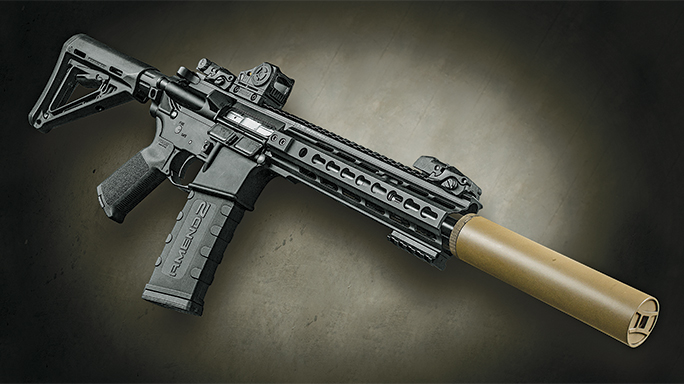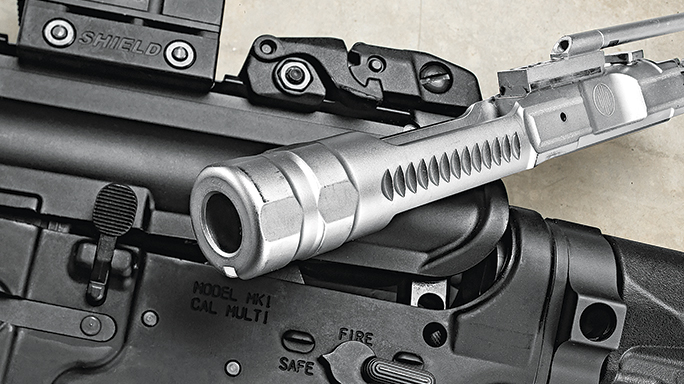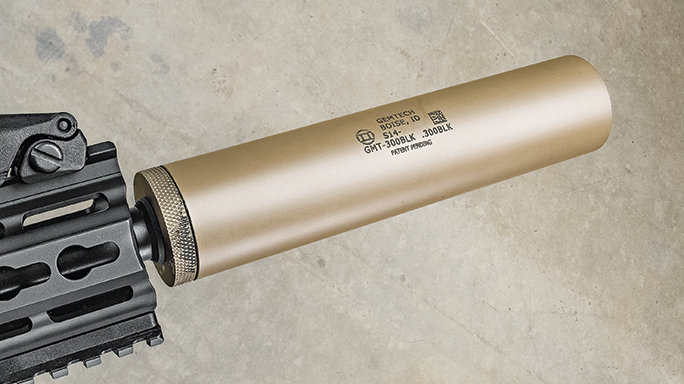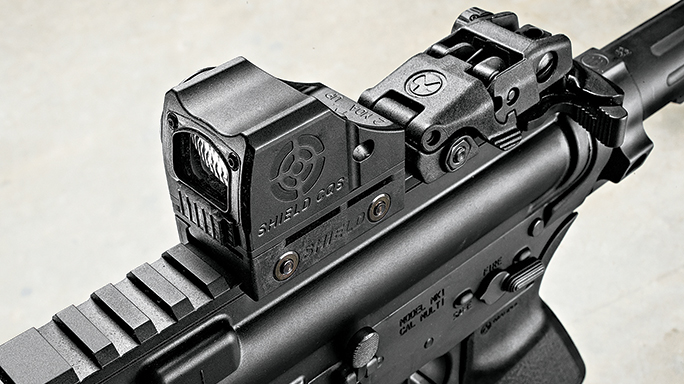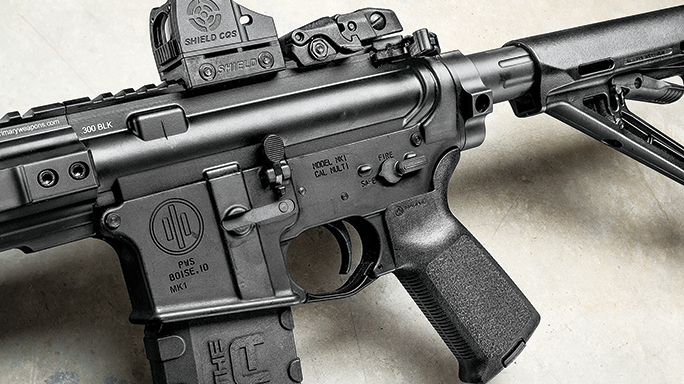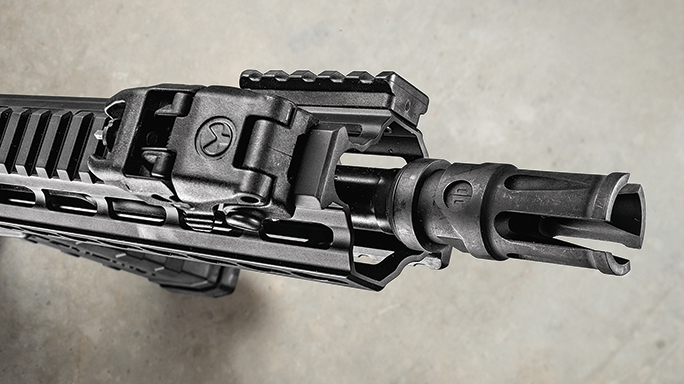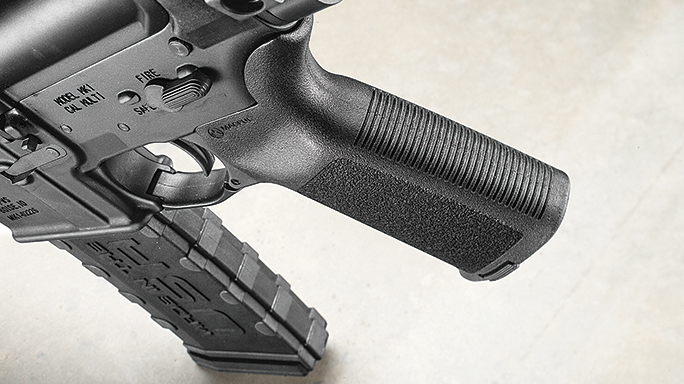It’s no mystery that Idaho-based Primary Weapons Systems (PWS) churns out some of the highest-quality AR (and now bolt-action) rifles around. After much success with its 5.56mm NATO and 7.62mm NATO/.308 Winchester rifles, PWS has turned its attention to the popular 300 Blackout as its next venture.
- RELATED STORY: MK220: Primary Weapons Systems’ Quiet 6.5mm Creedmoor AR
Shorter guns have garnered the attention of many, and this trend is only growing. These are several advantages to a shorter rifle, including improved maneuverability and concealability, with the former being a significant factor in the home-defense role and the latter in a car/truck/backpack weapon role.
The continued development of performance ammunition across all calibers makes ballistics less of a concern and even more so with larger calibers such as the 300 Blackout, which offers excellent terminal performance from shorter barrels. Add to that the ability to be effectively suppressed through the use of subsonic and even supersonic ammunition and you have a platform that makes a lot of sense, with few negatives.
Advertisement — Continue Reading Below
Piston Power
The MK109 follows PWS’ piston-driven lineage. It operates via a long-stroke piston system that functions much like that of the AK platform. This long-stroke function results in a smoother recoil impulse that is sometimes absent in short-stroke piston systems. It’s also very durable and will stand up to a significant amount of hard use.
The MK109 comes with a 9.75-inch, chrome-lined barrel, which is just a tad longer than the minimum length required for optimal 300 BLK powder burning. Additional barrel length can yield slightly higher velocities, but not enough to warrant any true requirement for it. This is why the 300 BLK and short-barreled rifles (SBRs) go hand in hand. PWS’ barrels come with an Isonite QPQ coating that enhances their strength and helps resist corrosion. PWS barrels are all turned in-house so that the company can control their quality. Also, the MK109’s barrel has a 1-in-8-inch twist rate.
Advertisement — Continue Reading Below
In an interesting move, PWS did not equip the MK109 with an adjustable gas system, unlike the company’s other rifles. Due to its special nature, the MK109 is gassed to run reliably with certain types of ammunition, both suppressed and unsuppressed. PWS suggests full-power loads of 110 grains up to 130 grains for optimum, reliable, unsuppressed functioning. Thus, 147-grain ammo falls outside of PWS’ suggested range for unsuppressed usage.
- RELATED VIDEO: New For 2016: Primary Weapons Systems’ MK1 MOD 2 Rifle
Surrounding the barrel and gas piston system is PWS’ MK1 KeyMod handguard. Constructed from aircraft-grade aluminum, this handguard is lightweight and tough. Along with a full-length Picatinny top rail, the MK1’s KeyMod sides make it easy to add accessories or establish a firm grip. My test rifle also came with small Picatinny rail sections to outfit the rifle with other accessories as needed. Quick-detach (QD) sling attachment points are present on both sides at the rear of the handguard.
The MK109’s upper and lower receivers are forged from mil-spec 7075-T6 aluminum, which is standard fare. But I have to say that the receivers exude PWS’ attention to detail and quality, something you might not find with other brands. The receivers are machined to near perfection. You’ll only notice smooth, clean lines and angles, and the upper receiver interfaces cleanly with the forend. You actually have to study the MK109’s upper closely to see that it’s not a monolithic receiver.
Advertisement — Continue Reading Below
The pistons’ operating rod is connected to PWS’ bolt carrier, which is designed with increased mass. The carrier is cut in such a way to have fewer contact points within the receiver for more efficiency. A glance at this carrier shows the same sort of meticulous attention to detail that you’ll find on the exterior of the MK109. The rear of the carrier is built up and wider in diameter to prevent carrier tilt. This works in conjunction with PWS’ unique MK1 buffer tube, which has an extension or “lip” that interfaces farther into the receiver to support the wider rear of the carrier. The carrier and bolt are nickel-Teflon coated. To further help with reliability, a small “assist spring” is added to the rear of the bolt, and a BCM Gunfighter charging handle is installed.
The buffer tube is a one-piece design with built-in QD attachment points on the left and right sides, and because of the way it indexes with the receiver, there’s no need for a castle nut. But PWS doesn’t stop there. The buffer tube is fluted with channels so that debris can be more easily removed, and drain holes are present to allow water to escape. Even the buffer is designed for more efficient operation with raised points in a triangular pattern that create yet another channel for debris. This should help the buffer move more freely as it gets dirtier within the gun.
Both receivers are hardcoat anodized and look good. The controls are standard AR, and the lower is furnished with an enlarged triggerguard as well as Magpul’s MOE stock and pistol grip.
Advertisement — Continue Reading Below
Although the MK109 comes with PWS’ own Triad flash suppressor, I removed it so I could install a sound suppressor to test the rifle’s functioning in this mode. Suppressors are more popular than ever, and there are countless options available for 300 BLK firearms. So, to test the MK109, I attached Gemtech’s GMT-300BLK suppressor. It features a monocore baffle design and is lightweight. It is also specifically designed for use with the 300 BLK and is full-auto rated with both supersonic and subsonic ammunition.
The MK109 comes with Magpul backup sights, but I also added the British-made Shield CQS (Close Quarter Sight) for testing. This red-dot sight is small and lightweight at 2.3 ounces, and is currently in use with British and Canadian military forces. The housing is constructed of anodized aluminum, and the Shield automatically adjusts to ambient light. In testing, the reticle is actually very bright in sunlight.
Range Time
Advertisement — Continue Reading Below
At the range, I began testing the MK109 by shooting five-shot groups at 100 yards with supersonic ammunition. Black Hills’ 125-grain OTM rounds and Gemtech’s 125-grain Nosler ammo were neck and neck in the accuracy department, but Black Hills won with a best five-shot group of 1.21 inches, besting the Gemtech’s 1.25-inch presentation. HPR’s 110-grain TAC-TX ammo printed a 1.4-inch group, and I found all of these loads to be acceptable performers. I’d bet with more rounds and break-in that the barrel will get better and groups will shrink. Testing other types of ammo could reveal that this gun is a sub-MOA SBR. My results were very encouraging.
Suppressed shooting was uneventful. While I didn’t shoot for groups, I did test subsonic loads from the same manufacturers as the supersonic for functioning. The MK109 functioned flawlessly with all subsonic loads, including Gemtech’s 147-grainers, without the suppressor attached. Also, the amount of blowback was minimal across all loads while suppressed.
- RELATED STORY: Gun Test: Primary Weapons Systems’ MK116 5.56mm Rifle
The Primary Weapons Systems MK109 was a pleasure to shoot all around. It has a light recoil impulse and is very manageable. The gun is extremely light to boot. One could get spoiled by its manners. Many manufacturers are making 300 Blackout guns, but the MK109 seems to be a standout in a crowded room. It’s hard to be definitive where it ranks because I obviously haven’t tested all of them. But I’d bet, based on Primary Weapons Systems’ excellence in design, machining, innovation and refinement, that the MK109 would be near the top of any dance card.
Advertisement — Continue Reading Below
For more information, call 208-344-5217 or visit primaryweapons.com.
Specifications
- Caliber: 300 BLK
- Barrel: 9.75 inches
- OA Length: 25.6 inches
- Weight: 6.06 pounds (empty)
- Stock: Magpul MOE
- Sights: Magpul MBUS
- Action: Piston-operated semi-auto
- Finish: Matte black
- Capacity: 30+1
- MSRP: $1,950
